Today’s view from the terrace
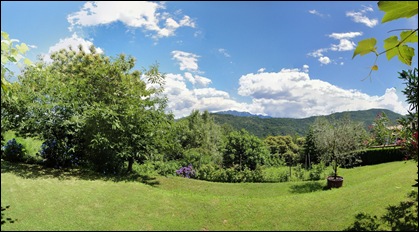
Labels: Picture Post
Reflections and observations on the expatriate experience from an American scientist living and working in the Netherlands.
This is the view from above the house in Agra, looking roughly north along the valley towards Lugano. It’s beautiful summer up here; the storms last night washed out the mist and humidity and left the day feeling scrubbed and crystalline.
Across the center of the scene is the long orange boom of a tower crane, occasionally in use to build a new house a couple of lots over. It’s always visible off the side of the terrace, outlined against the sky while I work, humming at work while I relax. It’s sort of inevitable that it would become a focus for thought.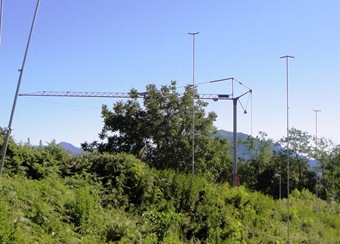
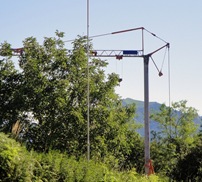 The projecting struts where the boom meets the column are particularly interesting. Why did the designer choose those exactly lengths, positioned at precisely those angles? In general, elements under tension can be distinguished from those under compression by their thickness: any slender pieces of rigging or scaffolding are being pulled apart rather than pushed together. The whole circle of connecting segments transfers the weight of the boom around towards the ground, but why the bit projecting towards the bottom right? Is it for added tension, safety, or some sort of stand-off?
The projecting struts where the boom meets the column are particularly interesting. Why did the designer choose those exactly lengths, positioned at precisely those angles? In general, elements under tension can be distinguished from those under compression by their thickness: any slender pieces of rigging or scaffolding are being pulled apart rather than pushed together. The whole circle of connecting segments transfers the weight of the boom around towards the ground, but why the bit projecting towards the bottom right? Is it for added tension, safety, or some sort of stand-off?
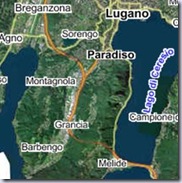 along the via Quandrella, center of each picture.
along the via Quandrella, center of each picture.When I first started learning watercolor painting, my teacher told me that each brushstroke was final: it could not be taken away or corrected. I quickly concluded that a rule like that would either make a new man of me or destroy me.
The enforced stillness and thoughtfulness during this convalescence will have a similar challenge, I think: lots of opportunity and peril in extended self-conversations.
Labels: Idle chit-chat
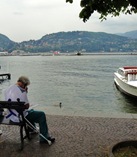 I moved across the lake today: a planned trade of one apartment for another, gaining some proximity to Lugano and a bit more quiet above the valley. The quality and value of these holiday apartments has really been outstanding, I took a leap of faith booking in sight unseen, but the locations, families, and facilities have been perfect.
I moved across the lake today: a planned trade of one apartment for another, gaining some proximity to Lugano and a bit more quiet above the valley. The quality and value of these holiday apartments has really been outstanding, I took a leap of faith booking in sight unseen, but the locations, families, and facilities have been perfect.
I went shopping for a place to stay in the local “Holiday Apartments” guide, looking for a bed, bath, kitchenette, wi-fi connection, and few stairs. The flats are all keyed with their amenities, and are generally set into a potion of a family home with a private entrance and outdoor terrace. In comparison to Lugano city hotels (low-end at 80 euro per night), these were 50 euro per night / 300 per week. The families are very kind, available if you want them and invisible otherwise, and the facilities are complete and well maintained. They take pride in the neighboring area, and are happy to provide maps and directions for local villages and hiking trails.
I may never do another hotel on holiday if this keeps up…I’m only sorry that I can’t take advantage of the wonderful natural areas nearby.
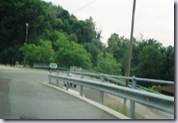 The only disadvantage has been that the homes are isolated on mountaintop villages, with impossibly narrow hairpin roads and honking Italian drivers to contend with at every turn. Grocery shopping and cultural attractions are about 5-10 km away, which is a major outing given my current mobility.
The only disadvantage has been that the homes are isolated on mountaintop villages, with impossibly narrow hairpin roads and honking Italian drivers to contend with at every turn. Grocery shopping and cultural attractions are about 5-10 km away, which is a major outing given my current mobility.
I did get to Como during the move: it’s a resort town at the north end of Lake Como in Italy. The border crossing has been reduced to a wave-through on both sides: it was casual last year and has reduced to just a rolling inconvenience this year.
Como’s waterfront is set between gamboge-Mediterranean architecture and steep veridian-green hills against a smooth lake. Uniformed crew run to meet the boats that run people up, down and across: captains polish the wood and brass between passenger loadings.
Although there’s block-modern architecture creeping in, the town keeps a resort charm. Men wear sunglasses, dark jackets, and pastel pants; the women turn out in light, swirling dresses and heels. A dozen languages are exchanged in the ice cream shops, although the waiters stubbornly stay with Italian.
Labels: Travel stories
 Note: Pix are from my aerie at Morbio Superiore.
Note: Pix are from my aerie at Morbio Superiore.
When I decided to have elective surgery in Europe, I was covered by an American health care plan. Economic, cultural, and practice differences assure that this will not be an easy union, and my case worker at WorldWide worked with me for weeks as we put the deal together. She was great and everything worked out fine, but I thought it was worth recounting some of the experiences for those facing similar circumstances.
0) During the pre-surgical workup, I needed to pay bills out-of-pocket before leaving the doctor’s office, then submit the paperwork to WorldWide for reimbursement. The x-rays were non-controversial, well documented and covered. The consultation with the surgeon was reimbursed at 10%, supposedly due to incorrect procedure coding.
Since the doctor’s report (in Italian) is translated by WorldWide before being processed by their US payment group, the error was internal, but took a month to even get that acknowledged. Time differences and their reluctance to make international phone calls complicated the process further. Keep all documentation and be prepared to follow-up relentlessly if reimbursement falls inexplicably short.
1) Prior to admission, there are two issues to be overcome, and the provider asks for two weeks to resolve them with the hospital.
One was to determine whether the hospital was an in- or out- of network, and thus eligible for 90% or 70% coverage of the procedure, respectively. The provider first issued estimates supporting both conclusions, forcing another review.
The second was what my out-of-pocket limit would be: by limiting both their payment and my exposure, the hospital had to accept some risk as well. In the end, it was around $3000, above the yearly maximum deductable for the policy, which I still need to sort out.
At that point a Guarantee of Coverage (GOC) is issued: get a copy as it’s your contract for the care. Until that document is available, the prep is not complete.
I’d say that the ‘two week’ rule is really a minimum: in practice, things can take longer, and I was literally on the phone with the case managers up to the final night.
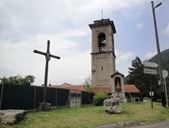 2) Once admitted, the insurance proceeds incrementally, which confused the doctors and hospital a lot. Aimed at assuring quality and managing cost, it’s a surprising bit of over-control and micro-management that baffles the Europeans. The provider pre-approves the first two days of care, then reviews the case to determine what to approve for the next two days, and so on.
2) Once admitted, the insurance proceeds incrementally, which confused the doctors and hospital a lot. Aimed at assuring quality and managing cost, it’s a surprising bit of over-control and micro-management that baffles the Europeans. The provider pre-approves the first two days of care, then reviews the case to determine what to approve for the next two days, and so on.
It leads to a recurring comedy of communications.
Questions would be faxed in from the US, the doctor would come ask why he was getting questions, I’d look for someone who understood US procedures enough to answer, WorldWide would call the doctor’s cell, I’d call WorldWide: it became a very active rotation.
3) Some in-hospital costs were not covered: I was given a pair of crutches and asked for 68 CHF, cash, to cover them. The pharmacy charges for discharge meds (150 CHF) and admission deductable (50 CHF) could slip onto a visa card.
It’s best to be prepared with a contingency fund and a card with an adequate credit limit in case this comes up.
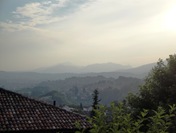 While everything has worked out well and I believe that everything was finally covered, there are a few take-home lessons to offer:
While everything has worked out well and I believe that everything was finally covered, there are a few take-home lessons to offer:
Labels: Health Care
 It’s finally turning cloudy and cooler in the southeast Swiss hills. The weather has been brutally hot and sunny for the past few days, well above 30C, but the temperatures moderate agreeably and the breezes return each evening. It’s been nice to sit out over a late meal and watch twilight fall across the valley below, keeping both my foot and my spirits elevated.
It’s finally turning cloudy and cooler in the southeast Swiss hills. The weather has been brutally hot and sunny for the past few days, well above 30C, but the temperatures moderate agreeably and the breezes return each evening. It’s been nice to sit out over a late meal and watch twilight fall across the valley below, keeping both my foot and my spirits elevated.
The aerie is near the border town of Morbio Superiore (superior death?), not too far from Lake Como and about 20 minutes from the hospital in Lugano. This was my first ‘patient-perspective’ experience with heavy-duty European health care: Americans are parochial about the technical superiority of their hospitals, and I admit that I approached my admission here with some misgivings. However, things have gone exceptionally well,
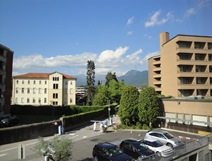 The Clinica Luganese is a private hospital in Lugano, one of several that serve specialty practices away from the larger public hospital. The orthopedic wing is open and modern, perhaps half filled with a mix of European and foreign patients, and an active teaching practice alongside the clinics. The parquet floors and abundant recessed lighting were modern and welcoming, and, although I took a semi-private room, I never had a roommate, so ended up with a lot of space and quiet.
The Clinica Luganese is a private hospital in Lugano, one of several that serve specialty practices away from the larger public hospital. The orthopedic wing is open and modern, perhaps half filled with a mix of European and foreign patients, and an active teaching practice alongside the clinics. The parquet floors and abundant recessed lighting were modern and welcoming, and, although I took a semi-private room, I never had a roommate, so ended up with a lot of space and quiet.
As a medical device guy, I naturally watched the technology: there was little difference in structure or procedure from what I would find in a US hospital. The trip through prep, surgery, and recovery rooms matched similar facilities in Seattle, I don’t think that there are any special risks to having procedures done out of the country if you have confidence in the doctor and have previewed the facility. Payment can be complicated, though; more about that tomorrow.
The other nice aspect was the meals: although dietary restrictions were in place, the food was delightfully Tuscan-Italian styled. Good breads and salads, pasta and coffee, were the norm, bottled water instead of tap. Apparently ‘vino’ was also available for purchase, although I didn’t try it. Days started early: vitals at 6 am, breakfast at 7. Doctors made rounds in the evening rather than in the morning, and a music school up the block provided a nice backdrop of students practicing scales and pieces.
On the downside, fluency in English was rare: physicians do, but few others. So, from staff to television, everything was Italian with a smattering of French. I asked a friend to come up for a few days to translate, assuring that I could engage with the process: I think that this is a vital thing to plan for. While the staff was always smiling and helpful, there was a tendency to say “I’ll be right back” and then vanish: occasional assertiveness was needed. And a lot of the formal paperwork is missing: I was surprised that I was encouraged to wander out the door without a doctor giving instructions and signing my discharge.
 After leaving, it was my responsibility to get the post surgical meds, to secure local housing, and to arrange transportation. Again, it’s best to plan all of this ahead: the local VVV gave good guidance on rentals, and the staff was able to write down the address for a nearby pharmacy open on Sunday.
After leaving, it was my responsibility to get the post surgical meds, to secure local housing, and to arrange transportation. Again, it’s best to plan all of this ahead: the local VVV gave good guidance on rentals, and the staff was able to write down the address for a nearby pharmacy open on Sunday.
As the debate on US healthcare policy cranks up, I’m sure that there will be a lot of debate about the merits and faults of Europe’s models. I didn’t have any issues with quality of care or patient care procedures, lack of technology or infrastructure. There were far more similarities than differences; it was all much more familiar than I expected.
Labels: Health Care
Hi, all, I’m back, bonded with my computer and catching up with e-mail and everyone’s blog updates. It will take most of the week, I’m sure, but wanted to give a quick update on things as I got back on-line.
Some of you know that I’ve had a major misalignment of my left foot for several years caused by a congenital muscle condition: it’s made it increasingly difficult to walk and to do the things that I want to be dong. For the past year, I’ve been looking for an orthopedic surgeon who could get things fixed, and found a good one in Switzerland. I had to set up the insurance and find six weeks of time-off to get the procedure done, heal properly, and get through the physical therapy.
So, things came together last week, and I had the surgery done on Wednesday. Everything went well, and I’m out of the hospital and recovering nearby. The physician took a lot of time to preserve the nerve function, make the most of the tendons, and save the viable joints, so it ended up being a fairly extensive procedure. But we hope that it will give more lasting mobility and strength to the ankle, and restore function to be out hiking and sailing later this summer.
The outcome looks promising and it’s good to have the procedure behind me: ‘lots to catch up on in the coming days.
Labels: Idle chit-chat, Personal Background